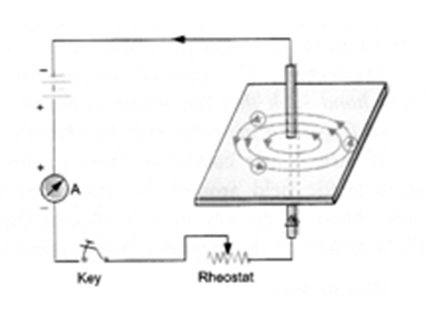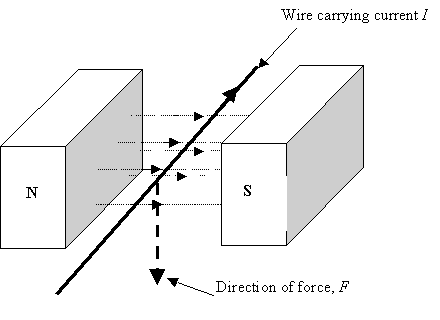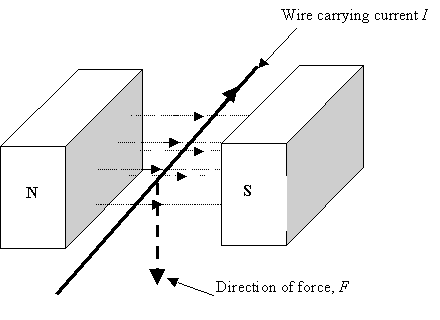Introduction
As we have already studied electricity and its effects you will be surprised to know that the magnetic effect and heating effect are after effects of current. In this chapter we are going to focus on the magnetism produced due to electricity and also electricity produced due to magnetism. So let us study about magnets and their properties.
At first, the magnetic concept came in to notice when it was observed that in the centre of the earth i.e. the core, there is a substance that can attract certain substances towards itself and that substance is regarded as a natural magnet called lodestone. Considering the properties of natural magnet, the man made magnets were developed. So let us define magnet first.

Magnet: It is an object which attracts pieces of iron, steel, etc. towards itself.
Man made magnets are of different shapes like
- Bar magnet- a long rectangular piece of magnet
- Horseshoe shaped- U shaped magnet
- Magnetic needle



- Magnetic compass
Some facts about magnets:-
- When a magnet is freely suspended, it always aligns towards north-south direction.

- Like poles always repel & opposite poles attract each other.

- Magnet always exists as dipole

- Two poles can never be separated: if we try to cut them then also, both the poles will exist even in a small piece of magnet. It automatically develops the lost polarity.

- A magnet always develops certain area around it where its effect can be felt i.e. magnetic field.
Magnetic field
It is studied by drawing imaginary lines called magnetic lines of forces.

Characteristics of Magnetic Field:
- They always originate from north pole & terminate at the south pole. This shows that if the north pole was free, it would have moved towards the south pole.
- The place where they are closer indicates a strong magnetic field i.e. at the poles.
- Magnetic Field lines give the direction of magnetic force.
- Two magnetic lines will never intersect each other as they give direction of force & force can not have 2 directions at a time.
- Magnetic Field lines are closed continuous curves.

Magnetic lines produced around bar magnet :
Oersted’s experiment :-
He conducted an experiment and proved that a wire carrying an electric current produces a magnetic field around it. The direction of magnetic field was confirmed by the deflection of magnetic needle kept near the current carrying conductor or we can say near the circuit. The rules that are given are listed below :

Ampere swimming rule: Suppose a person is swimming in the direction of current such that current enters the man through his feet and leaves his body through his head, then the magnetic needle kept below it will get deflected towards it.

Snow rule: According to this rule, when the current flows from the south to the north, the needle deflects towards the west.
Magnetic field produced by straight conductor

Characteristics:
(a) Magnetic lines are concentric circles.
(b) The direction of magnetic lines reverses as we reverse the direction of the current.
When current flows upward, the direction of magnetic lines is anticlockwise.
When current flows downward, the direction of magnetic lines is clockwise.
(c) The Magnetic field produced is directly proportional to the current & inversely proportional to the distance from the conductor.
(d) To know the direction of magnetic field around a straight conductor, we have different sets of rules as given below:
- Right hand thumb rule: Suppose you grasp the conductor in your right hand such that the thumb points in the direction of the current, then the direction in which your fingers curl gives the direction of the magnetic field.

Magnetic field produced due to circular loop
The Magnetic field produced around a circular loop is also circular. As we move away from the loop, the concentric circle becomes bigger. At the centre, the magnetic lines are parallel.

Characteristics
- The magnetic lines are circular at the points from where the current enters or leaves the coil.
- Within the space enclosed by the coil, the field lines are in the same direction.
- Near the centre of the coil, the magnetic lines are almost parallel to each other.
- At the centre of the coil, the plane of magnetic field lines is at right angles to the plane of circular coil.
- Magnetic field produced is directly proportional to the current and inversely proportional to the distance from the conductor.
- The part from where the magnetic lines enter the coil facing us is considered as south pole and the other is north pole.
Current flowing clockwise = south
Current flowing anti clockwise = north
Magnetic field produced due to solenoid
Solenoid: It is a long coil containing a large number of turns of copper wire.

When solenoid is connected to a battery and current is passed through it, it also produces a magnetic field which is similar to the magnetic field produced around a bar-magnet i.e., one side of solenoid acts as the north pole & other as the south pole.
Strength of magnetic field can be changed by
- Increasing the amount of current.
- Increasing the number of turns of copper wire.
- Decreasing the gap between turns of copper wire.
- The nature of material used in making solenoid.
Electromagnet
It is a substance which starts behaving as a magnet when a current is passed through it but as the current is switched off, magnetism is lost.
- It consists of a long coil of copper wire wound on a soft iron core. The ends of the copper wire are connected to a battery.

Factors affecting the strength of an electromagnet are as follows:
Steel is not used for making electromagnet as it does not lose its magnetism even if the current is switched off i.e., it forms a permanent magnet.
Kicking wire Experiment

On pressing the switch, current flows in the wire in the downward direction as it is placed between the poles of the magnet because force acts on it and wire gets displaced from its original position. As it gets displaced, the circuit breaks and the flow of current stops due to which no force acts on the wire and it returns to its original position. Again, the circuit gets completed, force acts and the wire get displaced. This is how it goes on repeating.
Fleming’s left hand rule
Stretch your forefinger, centre finger & thumb mutually perpendicular to each other such that the fore finger points in the direction of the magnetic field. The centre finger indicates the direction of current & thumb gives the direction opf the force of motion.

Electric motor
It is a device which converts electrical energy into mechanical energy.

Principle- When a rectangular coil carrying current is placed in a magnetic field, it experiences a force that rotates it.
B1 & B2 - Brushes.
Function: To make contact with split rings. Split Rings Commutator formed by splitting of copper ring. Its function is to reverse the direction of the current.
Working of Electric Motor
Imagine a coil ABCD is in a horizontal plane such that magnetic field is parallel to the plane of the coil. When electric current is passed through coil
A and B
- In segment AB current flows from A to B. Applying Fleming's left hand rule, we come to know that it experiences force in upward direction C and D.
- In segment CD, current flows from C to D and force acts downwards (By fleming's left hand rule).
- The two forces being equal and opposite form a couple and rotate the coil in clockwise direction.
When the coil turns an angle of 90o, commutator loses contact with brushes and thus, no force acts on the coil. But due to the momentum gained, the coil continues rotating till it covers an angle of 180o. After 180o, S1 connects with brush B2 and S2 connects with B1. This alters the direction of current in coil and new current flows in the direction BADC. This is how electric motor’s work.
Electromagnetic induction
The production of electricity from magnetism is called electromagnetic induction.

Experiment: Wire AB is held between the poles of a magnet. Two ends of the wire are connected to a galvanometer. Still no current is produced but when the wire is in motion between poles of magnet, it cuts the magnetic lines, due to which the strength of the magnetic field is changed and current is induced in the wire.
It is defined as the production of current in a conductor when the conductor is moved between the poles of the magnet. The current produced is called induced current.

Fleming’s right hand rule
Stretch your forefinger, center finger and thumbs mutually perpendicular to each other such that the forefinger points in the direction of magnetic field. The thumb points in the direction of motion & center finger indicates the direction of induced current.

Lenz’s law
In all the cases of electromagnetic induction, the direction of induced current is such that it always opposes the cause that produces it. For Example: When north pole of magnet is approaching the end A of the coil, then the direction of induced current is such that it opposes the motion of the north pole towards A.

AC generator
It is a device which converts mechanical energy into electric energy.
Principle:- When the conductor is moved in the magnetic field then the current is induced in the conductor.
Working of AC Generator
Imagine that a coil ABCD is in a horizontal position. Now, it is rotated in an anticlockwise direction between poles of magnet by rotating its shaft. When coil rotates, AB of coil moves down, cutting magnetic field lines of north pole and CD moves up, cutting magnetic field lines of south pole. Due to this, induced current is produced. Applying Fleming’s right hand rule,
Direction of current is B to A and D to C i.e. BADC
After half rotation, sides AB and CD will interchange their position, so, AB starts moving up and CD moves down. Induced current is produced.
Direction of current
C to D and A to B i.e. CDAB
External circuit current flows from B2 to B1.
Earthing
Electrical appliances are always touched by hands. There can be a chance that the insulation breaks or cracks and the bare wire touches the metal case and then the person touching them might get a shock. To avoid such incidents, the metal cases are earthed. By earthing we mean that the metallic body is connected to a thick copper wire which is buried deep under the earth. And at the end, the copper plate is surrounded by a mixture of charcoal and common salt.

The earth is always at 0 potential. So, if an electrical appliance gets short circuit, the current flows to the metal body deep inside the earth. If the magnitude of current rises due to short circuit, the fuse wire melts but the appliance or the user will not receive any current as it is earthen.
For More Notes of Different Chapters - Click Here








0 Comments